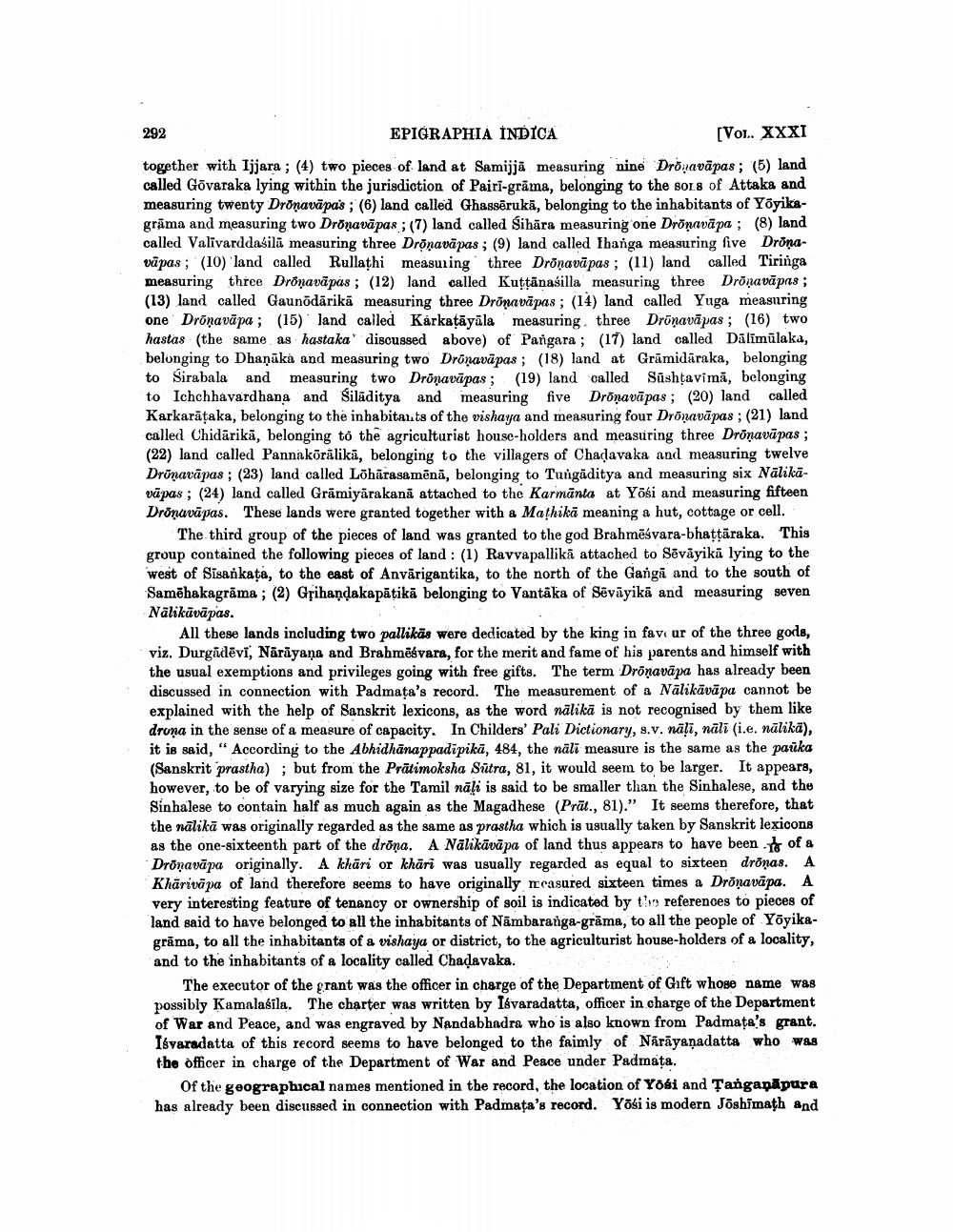________________
292 EPIGRAPHIA INDICA
[Vol. XXXI together with Ijjara ; (4) two pieces of land at Samijjá measuring nine Drönavāpas ; (5) land called Govaraka lying within the jurisdiction of Pairi-grāma, belonging to the sons of Attaka and measuring twenty Drðnavāpas ; (6) land called Ghassērukā, belonging to the inhabitants of Yöyikagrama and measuring two Drönavāpas ; (7) land called Sihāra measuring one Drönavāpa ; (8) land called Valivarddasilā measuring three Drönaväpas ; (9) land called Thanga measuring five Dronavāpas ; (10) land called Rullathi measuring three Drönavāpas ; (11) land called Tiringa measuring three Drönavā pus; (12) land called Kuttanasilla measuring three Dronavāpas ; (13) land called Gaunādārikā measuring three Drõnavāpas ; (14) land called Yuga measuring one Dronavāpa; (15) land called Kárkatāyāla measuring three Drūnavāpas ; (16) two hastas (the same as hastaka' discussed above) of Pangara; (17) land called Dalimülaka, belonging to Dhaņāka and measuring two Dronavāpas ; (18) land at Grāmidāraka, belonging to Sirabala and measuring two Dronavāpas; (19) land called Süshtavimā, belonging to Ichchhavardhana and Siladitya and measuring five Drönavāpas ; (20) land called Karkarātaka, belonging to the inhabitants of the vishaya and measuring four Drönavāpas ; (21) land called Chidūrika, belonging to the agriculturist house-holders and measuring three Drönavāpas ; (22) land called Pannakörälikā, belonging to the villagers of Chaclavaka and measuring twelve Drūnavāpas ; (23) land called Löhürasamēnā, belonging to Tungaditya and measuring six Nālikāvūpas ; (24) land called Gramiyarakani attached to the Karmänta at Yöbi and measuring fifteen Dronavāpas. These lands were granted together with a Mathikā meaning a hut, cottage or cell.
The third group of the pieces of land was granted to the god Brahmēsvara-bhattāraka. This group contained the following pieces of land : (1) Ravvapallika attached to Sēvāyikā lying to the west of Sisankata, to the east of Anvärigantika, to the north of the Ganga and to the south of Samēhakagrāma; (2) Grihandakapātikā belonging to Vantaka of Sēvāyikā and measuring seven Nalikuυάμας.
All these lands including two pallikäs were dedicated by the king in favı ur of the three gods, viz. Durgūdēví, Nārāyana and Brahmēsvara, for the merit and fame of his parents and himself with the usual exemptions and privileges going with free gifts. The term Drönavāpa has already been discussed in connection with Padmata's record. The measurement of a Nālikāvāpa cannot be explained with the help of Sanskrit lexicons, as the word nālikā is not recognised by them like drona in the sense of a measure of capacity. In Childers' Pali Dictionary, s.v. nāli, nāli (i.e. nālikā), it is said, " According to the Abhidhānappadipikā, 484, the näli measure is the same as the pauka (Sanskrit prastha) ; but from the Prātimoksha Sutra, 81, it would seem to be larger. It appears, however, to be of varying size for the Tamil nāli is said to be smaller than the Sinhalese, and the Sinhalese to contain half as much again as the Magadhese (Prüt., 81)." It seems therefore, that the nālikā was originally regarded as the same as prastha which is usually taken by Sanskrit lexicons as the one-sixteenth part of the dröna. A Nālikāvāpa of land thus appears to have been its of a Drönavāpa originally. A khāri or khari was usually regarded as equal to sixteen droņas. A Khārivāpa of land therefore seems to have originally measured sixteen times a Drönavāpa. A very interesting feature of tenancy or ownership of soil is indicated by the references to pieces of land said to have belonged to all the inhabitants of Nămbaranga-grāma, to all the people of Yöyikagrāma, to all the inhabitants of a vishaya or district, to the agriculturist house-holders of a locality, and to the inhabitants of a locality called Chadavaka.
The executor of the grant was the officer in charge of the Department of Gift whose name was possibly Kamalasila. The charter was written by Isvaradatta, officer in charge of the Department of War and Peace, and was engraved by Nandabhadra who is also known from Padmata's grant. Isvaradatta of this record seems to have belonged to the faimly of Nārāyanadatta who was the officer in charge of the Department of War and Peace under Padmata.
Of the geographical names mentioned in the record, the location of Yobi and Tangapāpura has already been discussed in connection with Padmata's record. Yösi is modern Jõshimath and




